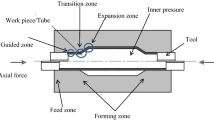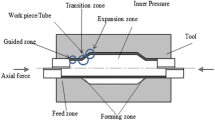Abstract
Tube hydroforming (THF) experiments were performed on TP2 copper tubes under different loading velocities and fluid velocities using a self-developed measurement system to investigate dynamic frictional characteristics in the guiding zone. The results show that the coefficient of friction (COF) dynamically changes during forming experiments and decreases with tube deformation. The average descending rate and amplitude of the COF increase with increasing loading velocity. Microscopically, the micro-protrusions on the tubular surface are flattened, and the surface scratches are finer and more uniform, as the loading velocity increases, resulting in a decrease in COF. At the same external loading velocity, the COF increases with increasing fluid velocity and is also extremely sensitive to it. Moreover, improving and predicting the formability of such tubes by accurately adjusting and controlling fluid velocity in THF is valuable and critical for the future.









Similar content being viewed by others
Abbreviations
- l 0 :
-
Initial tubular length [mm], Fig. 1
- l g :
-
Initial guiding zone length [mm], Fig. 1
- l b :
-
Initial forming zone length [mm], Fig. 1
- D 0 :
-
Initial tubular outer diameter [mm], Fig. 1
- t 0 :
-
Initial tubular thickness [mm], Fig. 1
- A :
-
Cross-sectional area of the fluid or tube [mm2], Eq 2
- r, R :
-
Maximum and minimum radii of the cylinder fluid [mm], Eq 4
- F x :
-
Pushing force on the right lower die in the x-axial direction [N], Fig. 3
- F f :
-
Friction force the tube and dies in the guiding zone [N], Fig. 3
- F z :
-
Force in the z-axial direction measured by load cell 2 or 3 [N], Fig. 3
- P i, P j :
-
Hydraulic pressure in the tube at the next and previous moments [MPa], Eq 1
- △p :
-
Hydraulic pressure difference inside the tube [MPa], Eq 1
- P 0-3 :
-
Initial hydraulic pressure in the inner tube and hydraulic pressure generated by a different pressure generating system [MPa], Fig. 2
Fig. 2 Schematic diagram of the self-developed measurement platform to determine the coefficient of friction (COF) in the guiding zone. The measurement platform has three hydraulic oil flow paths (I, II, and III) through three pressure generating systems and finally realizes the COF measurement between the TP2 copper tubular guiding zone and the die under three loading velocities
- N :
-
Normal contact force between the tube and dies in the guiding zone [N], Fig. 4
- F :
-
Pushing force generated by the hydraulic pressure difference [N], Eq 1
- f :
-
Internal friction force produced between the liquid layers [N], Eq 2
- V :
-
Loading velocity of the pressure generating system [mm/s], Fig. 2
- μ 0 :
-
Fluid viscosity of No. 46 hydraulic oil [Pa s], Eq 2
- u d :
-
Fluid velocity distribution inside the tube [mm/s], Eq 4
- u max :
-
Fluid velocity inside the tube [mm/s], Eq 5
- μ :
-
Coefficient of friction (COF) in the guiding zone of the tube, Fig. 4
- h :
-
Bulging height of the tube after tube hydroforming (THF) experiments, Table 6
- t r :
-
Size of rupture position of the tube after THF experiments, Table 6
- h a :
-
Mean of bulging height of the tube after THF experiments, Table 6
References
S. Kaya, Evaluating Porthole and Seamless Aluminum Tubes and Lubricants for Hydroforming, Int. J. Adv. Manuf. Technol., 2015, 77, p 807–817
J.P. Ma and L.F. Yang, Measurement Methods of Friction Coefficient for Plastic Deformation of Metals under High Strain Rate, Mater. Sci. Forum, 2016, 878, p 127–131
F. Forouhandeh, S. Kumar, and S.N. Ojha, Recent Development of Hydroforming-A Review, Int. J. Adv. Manuf. Syst., 2015, 15, p 27–36
S.J. Hashemi, H.M. Naeini, G. Liaghat, R.A. Tafti, and F. Rahmani, Numerical and Experimental Investigation of Temperature Effect on Thickness Distribution in Warm Hydroforming of Aluminum Tubes, J. Mater. Eng. Perform., 2013, 22(1), p 57–63
A. Alaswad, K.Y. Benyounis, and A.G. Olabi, Tube Hydroforming Process: A Reference Guide, Mater. Des., 2012, 33, p 321–339
K. Jin, Q. Guo, J. Tao, J. Tao, and X.Z. Guo, A Modified Isotropic-Kinematic Hardening Model to Predict the Defects in Tube Hydroforming Process, J. Mater. Eng. Perform., 2017, 26, p 5188–5196
M.F. Naghibi, M. Gerdooei, and M.B. Jooybari, Experimental and Numerical Study on Forming Limit Diagrams of 304 Stainless Steel Tubes in the Hydroforming Process, J. Mater. Eng. Perform., 2016, 25, p 5460–5467
L.F. Yang, H.S. Rong, and Y.L. He, Deformation Behavior of a Thin-Walled Tube in Hydroforming with Radial Crushing Under Pulsating Hydraulic Pressure, J. Mater. Eng. Perform., 2014, 23(2), p 429–438
M. Ahmetoglu and T. Altan, Tube Hydroforming: State-of-the-art and Future Trends, J. Mater. Process. Technol., 2000, 98(1), p 25–33
M. Plancak, F. Vollertsen, and J. Woitschig, Analysis, Finite Element Simulation and Experimental Investigation of Friction in Tube Hydroforming, J. Mater. Process. Technol., 2005, 170, p 220–228
M.A. Chowdhury, D.M. Nuruzzaman, A.H. Mia, and M.L. Rahaman, Friction Coefficient of Different Material Pairs under Different Normal Loads and Sliding Velocities, Tribology in Industry, 2012, 34, p 18–23
M. KocË and T. Altan, An Overall Review of the Tube Hydroforming (THF) Technology, J. Mater. Process. Technol., 2001, 108, p 384–393
Y.M. Hwang, L.S. Huang, Friction Tests in Tube Hydroforming, Proc. IMechE., Part B: J. Eng. Manuf., 2005, 219(8), p 587–593
M. Plancak and F. Vollertsen, A Contribution to Determining the Friction Coefficient in Hydroforming of Tubes, Lubr. Sci., 2010, 9, p 219–230
H.K. Yi, H.S. Yim, G.Y. Lee, S.M. Lee, G.S. Chung, and Y.H. Moon, Experimental Investigation of Friction Coefficient in Tube Hydroforming, Trans. Nonferrous Met. Soc. China, 2011, 21, p 194–198
A. Fiorentino, E. Ceretti, and C. Giardini, Tube Hydroforming Compression Test for Friction Estimation-numerical Inverse Method, Application, and Analysis, Int. J. Adv. Manuf. Technol., 2013, 64(5–8), p 695–705
L.F. Yang, P. Lei, and C. Guo, The Influence of Friction on Forming Accuracy of Tubular Parts by Hydroforming with Radial Crushing, Adv. Mater. Res., 2011, 328–330, p 1386–1390
L.F. Yang, C.L. Wu, and Y.L. He, Dynamic Frictional Characteristics for the Pulsating Hydroforming of Tubes, Int. J. Adv. Manuf. Technol., 2016, 86, p 347–357
M. Ahmadpour and O. Ghahraei, The Impact of Die Corner Radius and Friction Coefficient on Bulge Forming of T-shaped Copper Tubes using Finite-element Method and Experimental Analysis, Adv. Des. Manuf. Technol., 2017, 10, p 31–38
A. Abdelkefi, P. Malécot, N. Boudeau, N. Guermazi, and N. Haddar, Evaluation of the Friction Coefficient in Tube Hydroforming with the “Corner Filling Test” in a Square Section Die, Int. J. Adv. Manuf. Technol., 2017, 88, p 2265–2273
M. Sasso, A. Forcellese, M. Simoncini, D. Amodio, and E. Mancini, High Strain Rate Behaviour of AA7075 Aluminum alloy at Different Initial Temper States, Key Eng. Mater., 2015, 651-653, p 114–119
D. Cui, L. Zhang, K. Mylvaganam, W. Liu, and W. Xu, Nano-milling on Monocrystalline Copper: A Molecular Dynamics Simulation, Mach. Sci. Technol., 2017, 21, p 67–85
L. Daw-Kwei, Modeling of Surface Roughness Effect on Dry Contact Friction in Metal Forming, Int. J. Adv. Manuf. Technol., 2011, 57, p 575–584
A. Anil Kumar, S. Satapathy, and D. Ravi Kumar, Effect of Sheet Thickness and Punch Roughness on Formability of Sheets in Hydromechanical Deep Drawing, J. Mater. Eng. Perform., 2010, 19(8), p 1150–1160
H. Naceur, S. Ben-Elechi, J.L. Batoz, and C. Knopf-Lenoir, Response Surface Methodology for the Rapid Design of Aluminum Sheet Metal Forming Parameters, Mater. Des., 2008, 29(4), p 781–790
P. Groche and A. Peter, Performance of Lubricants in Internal High Pressure Forming of Tubes, Adv. Technol. Plast., 2003, 44(507), p 382–384
J.Y. Xia, Z.Z. Song, J. Li, S.H. Li, and G.Z. Yu, Experimental Research of Correlativity of Friction Coefficient to Vertical Pressure and Friction Velocity in New Material FPB, 2016 International Conference on Materials Science, Resource and Environmental Engineering, AIP Conference Proceedings, 1794, p. 060002 (2017)
Acknowledgments
The authors gratefully acknowledge the support of the National Natural Science Foundation of China (No. 51564007), the Natural Science Foundation of Guangxi Province (Nos. 2017GXNSFAA198133 and 2015GXNSFBA139223), and Guangxi Key Laboratory of Manufacturing System & Advanced Manufacturing Technology (No. 14-045-15-005Z).
Author information
Authors and Affiliations
Corresponding author
Additional information
Publisher's Note
Springer Nature remains neutral with regard to jurisdictional claims in published maps and institutional affiliations.
Rights and permissions
About this article
Cite this article
Ma, J., Yang, L. & He, Y. Dynamic Frictional Characteristics of TP2 Copper Tubes during Hydroforming under Different Loading and Fluid Velocities. J. of Materi Eng and Perform 28, 3661–3672 (2019). https://doi.org/10.1007/s11665-019-04097-w
Received:
Revised:
Published:
Issue Date:
DOI: https://doi.org/10.1007/s11665-019-04097-w






